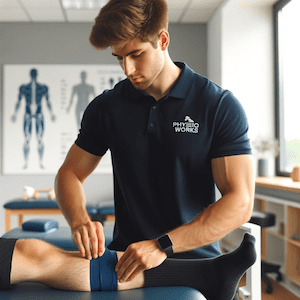Sub-Acute Soft Tissue Injury
Article by John Miller

Sub-Acute Soft Tissue Injury
A Comprehensive Guide to Treatment and Recovery
Introduction
When you experience a sub-acute soft tissue injury, it’s crucial to understand the role of physiotherapy in your recovery journey. This article, written from a physiotherapist’s perspective, aims to guide you through the process of treating sub-acute injuries. We’ll explore effective treatments and recent research to help you recover faster and more effectively.
Understanding Sub-Acute Injury Treatment
A sub-acute injury, which occurs after the initial acute phase of an injury, requires a careful approach to reduce inflammation, speed up the healing process, and prevent complications like joint stiffness, muscle tightness, and weakness. These issues can make you more susceptible to re-injury.
Local Modalities in Physiotherapy
Local modalities are potentially useful in the sub-acute phase. They include treatments like ice, heat, electrotherapy, therapeutic ultrasound and TENS machines. These methods may help in pain reduction and enhance the natural healing process by increasing energy in various forms (electrical, sound, light, magnetic, temperature). It’s important to view these modalities as short-term solutions, much like analgesics or NSAIDs, providing temporary relief while addressing the underlying cause of the injury.
Joint Mobilisation Techniques
Joint stiffness, often a complication of soft tissue injuries, can be effectively managed through skilled joint mobilisation techniques. These techniques, such as the Maitland and Mulligan methods, are employed by physiotherapists to restore full joint motion. They are selected based on a thorough assessment and discussion of any potential risks.
Protective Strapping and Support
To optimise tissue repair in the sub-acute phase, protective strapping or support may be recommended. This approach helps in limiting movement to allow the injured area to heal properly.

The Role of Exercise Prescription in Recovery
Exercise prescription is a cornerstone of sub-acute injury recovery. Tailored exercises, including specific stretching and strengthening routines, play a vital role in reducing pain, hastening recovery, and improving function post-injury. A physiotherapist can guide you in selecting the right exercises, focusing on core stability and adjacent muscle groups.
Incorporating Proprioceptive Retraining and Biomechanics Correction
Rehabilitation exercises also include proprioceptive retraining and biomechanics correction. These are essential for restoring normal movement patterns and preventing future injuries.
Conclusion
In conclusion, treating a sub-acute soft tissue injury involves a multifaceted approach that includes local modalities, joint mobilisation techniques, protective strapping, and a well-structured exercise prescription. With the guidance of a skilled physiotherapist, you can navigate your recovery efficiently and safely.
What to Do?
If you’re dealing with a sub-acute soft tissue injury, it’s crucial to seek professional advice. Consult a physiotherapist to get a tailored treatment plan that suits your specific needs. They will assess your injury, recommend the most appropriate treatments, and guide you through exercises that will aid in your recovery. Don’t hesitate to reach out to a physiotherapy clinic to take the first step towards a full recovery.
Rochedale - Call 38410277
Book Online: RochedaleSalisbury - Call 32751044
Book Online: SalisburySandgate - Call 32691122
Book Online: SandgateRelated Articles
- Early Injury Treatment – Readers will find information on immediate steps to take after sustaining an injury, aligning with the pre-sub-acute phase of injury recovery.
- Soft Tissue Massage – This page would discuss the benefits of massage therapy in the treatment of soft tissue injuries, supporting pain relief and promoting healing.
- Electrotherapy and Local Modalities – Offers insights into various electrotherapy treatments, which are mentioned as beneficial in the sub-acute phase for pain reduction and healing enhancement.
- Heat Packs Usage – Explains how heat therapy can aid in the recovery process by relaxing tight muscles and improving blood flow to the injured area.
- Kinesiology Tape – Provides information on how kinesiology taping can support injured soft tissue, reduce pain, and facilitate movement during the recovery process.
- Supportive Taping and Strapping – This article would outline the importance of taping and strapping in protecting the injured area, a strategy mentioned as key in the sub-acute phase.
- Exercise Prescription for Injury Recovery – While not directly found with this title, any article related to exercise prescription would be highly relevant, as exercise is a critical component of the recovery process described in the original article.
- Proprioceptive Training – A piece on proprioceptive retraining would complement the original article well by offering deeper insight into its role in preventing future injuries through improved movement patterns.
- Joint Mobilisation Techniques – An article detailing joint mobilisation methods could provide additional context to the techniques mentioned, helping readers understand how these can alleviate stiffness and restore motion.
















































































